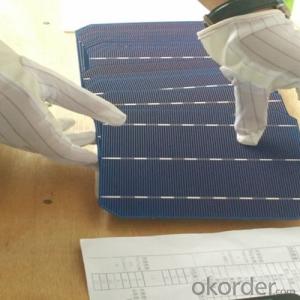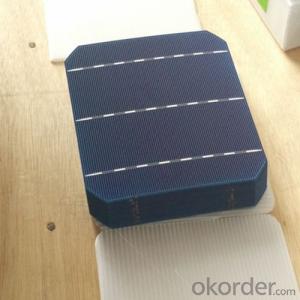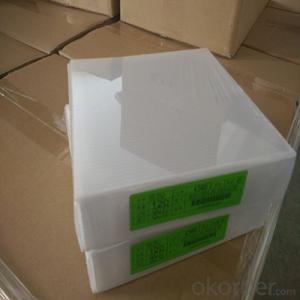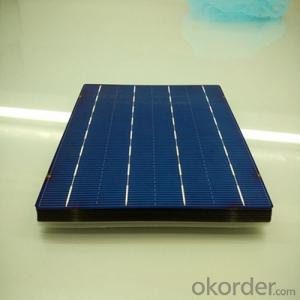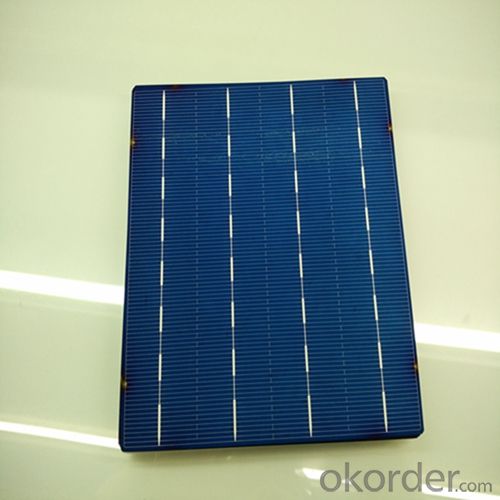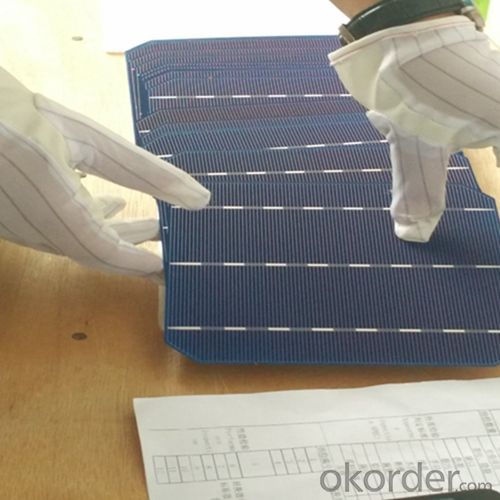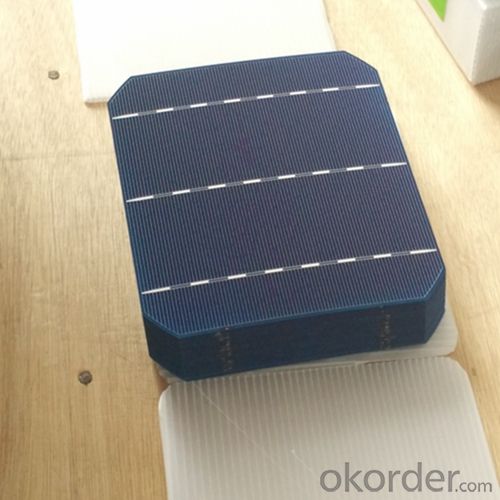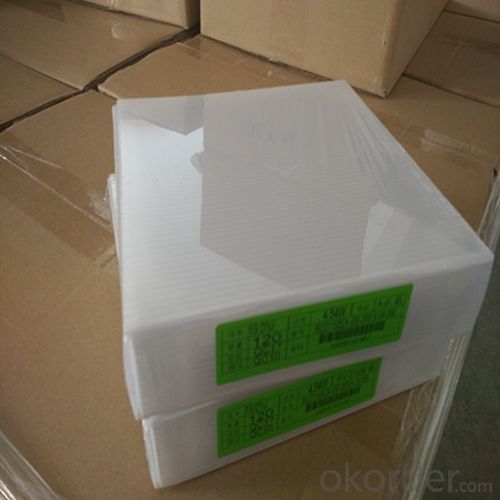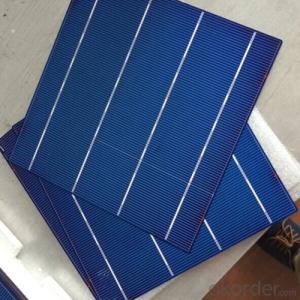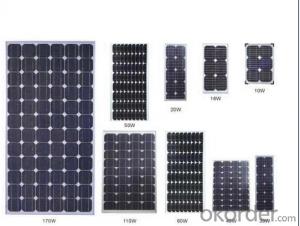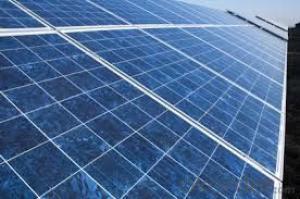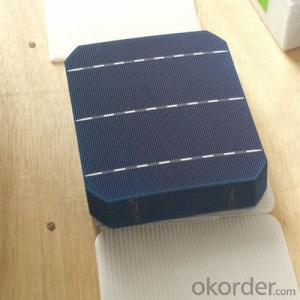Poly 156x156mm2 Solar Cells Made Class A - Solar Cells At Night
- Loading Port:
- Shanghai
- Payment Terms:
- TT OR LC
- Min Order Qty:
- 6500 watt
- Supply Capability:
- 6000000 watt/month
OKorder Service Pledge
OKorder Financial Service
You Might Also Like
The operation of a photovoltaic (PV) cell requires 3 basic attributes:
The absorption of light, generating either electron-hole pairs or excitons.
The separation of charge carriers of opposite types.
The separate extraction of those carriers to an external circuit.
In contrast, a solar thermal collector supplies heat by absorbing sunlight, for the purpose of either direct heating or indirect electrical power generation from heat. A "photoelectrolytic cell" (photoelectrochemical cell), on the other hand, refers either to a type of photovoltaic cell (like that developed by Edmond Becquerel and modern dye-sensitized solar cells), or to a device that splits water directly into hydrogen and oxygen using only solar illumination.Characteristic of Mono 156X156MM2 Solar Cells
You are gaining energy independence - add battery backup power for even greater energy security
The cost of electricity is only going to rise – insure against that rising cost
Adaptive cells change their absorption/reflection characteristics depending to respond to environmental conditions. An adaptive material responds to the intensity and angle of incident light. At the part of the cell where the light is most intense, the cell surface changes from reflective to adaptive, allowing the light to penetrate the cell. The other parts of the cell remain reflective increasing the retention of the absorbed light within the cell.[67]
In 2014 a system that combined an adaptive surface with a glass substrate that redirect the absorbed to a light absorber on the edges of the sheet. The system also included an array of fixed lenses/mirrors to concentrate light onto the adaptive surface. As the day continues, the concentrated light moves along the surface of the cell. That surface switches from reflective to adaptive when the light is most concentrated and back to reflective after the light moves along
Mechanical data and design
Format | 156mm x 156mm±0.5mm |
Thickness | 210μm±40μm |
Front(-) | 1.5mm bus bar (silver),blue anti-reflection coating (silicon nitride) |
Back (+) | 2.5mm wide soldering pads (sliver) back surface field (aluminium) |
Temperature Coefficient of Cells
Voc. Temp.coef.%/K | -0.35% |
Isc. Temp.coef .%/K | +0.024%/K |
Pm.Temp.coef. %/K | -0.47%/K |
Electrical Characteristic
Effiency(%) | Pmpp(W) | Umpp(V) | Impp(A) | Uoc(V) | Isc(A) | FF(%) |
18.35 | 4.384 | 0.526 | 8.333 | 0.63 | 8.877 | 78.39% |
18.20 | 4.349 | 0.526 | 8.263 | 0.63 | 8.789 | 78.54% |
18.05 | 4.313 | 0.525 | 8.216 | 0.63 | 8.741 | 78.32% |
17.90 | 4.277 | 0.524 | 8.161 | 0.625 | 8.713 | 78.04% |
17.75 | 4.241 | 0.523 | 8.116 | 0.625 | 8.678 | 77.70% |
17.60 | 4.206 | 0.521 | 8.073 | 0.625 | 8.657 | 77.36% |
17.45 | 4.170 | 0.519 | 8.039 | 0.625 | 8.633 | 76.92% |
17.30 | 4.134 | 0.517 | 8.004 | 0.625 | 8.622 | 76.59% |
17.15 | 4.096 | 0.516 | 7.938 | 0.625 | 8.537 | 76.80% |
17.00 | 4.062 | 0.512 | 7.933 | 0.625 | 8.531 | 76.18% |
16.75 | 4.002 | 0.511 | 7.828 | 0.625 | 8.499 | 75.34% |
16.50 | 3.940 | 0.510 | 7.731 | 0.625 | 8.484 | 74.36% |
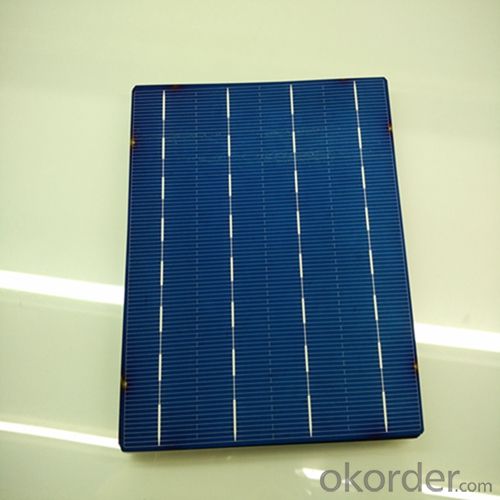
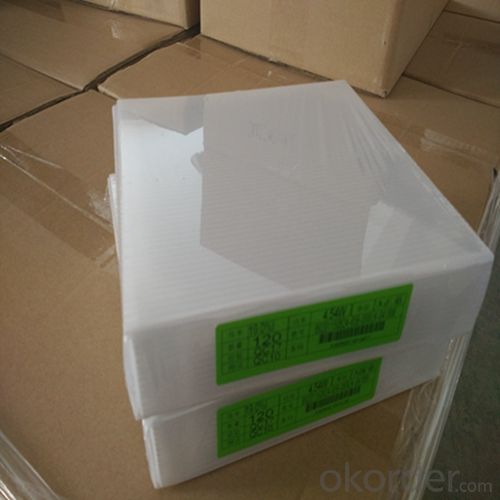
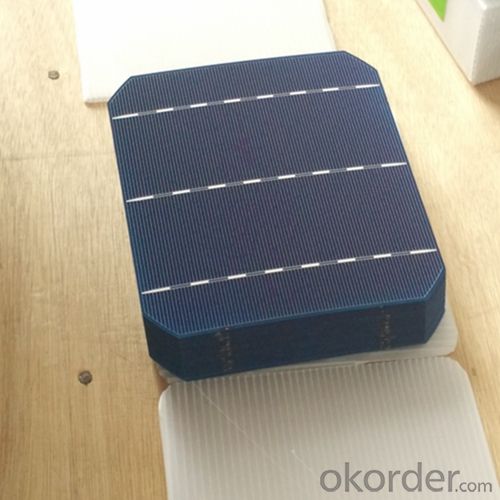
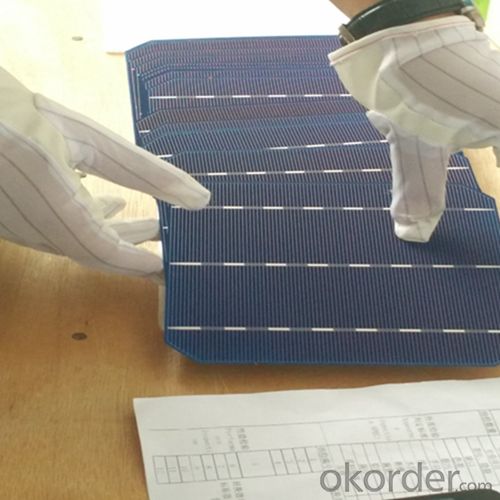
 FAQ
FAQ
Q: What price for each watt?
A: It depends on the quantity, delivery date and payment terms, generally Large Quantity and Low Price
Q: What is your size for each module? Can you tell me the Parameter of your module?
A: We have different series of panels in different output, both c-Si and a-Si. Please take the specification sheet for your reference.
Q: What is your size for each module? Can you tell me the Parameter of your module?
A: We have different series of panels in different output, both c-Si and a-Si. Please take the specification sheet for your reference.
- Q: What is the role of solar cells in powering outdoor lighting?
- Solar cells play a crucial role in powering outdoor lighting as they convert sunlight into electricity. This renewable energy source is harnessed by solar cells installed on outdoor lighting fixtures, allowing them to operate without the need for grid electricity. Solar cells capture sunlight during the day and store the energy in batteries, which is then used to power the outdoor lights during nighttime. This sustainable solution helps reduce carbon emissions, lowers energy costs, and provides reliable lighting in outdoor spaces, even in remote areas where electrical infrastructure may be limited.
- Q: Can solar cells be used for powering electric fences?
- Yes, solar cells can be used for powering electric fences. Solar cells convert sunlight into electrical energy, which can be stored in batteries and used to power electric fences. This provides a sustainable and environmentally-friendly solution for powering fences in areas where access to grid electricity is limited or expensive.
- Q: Can solar cells be used for desalination?
- Yes, solar cells can be used for desalination. Solar energy can be harnessed to power the desalination process, making it a sustainable and environmentally friendly option for producing fresh water from seawater.
- Q: Can solar cells be used in satellite or space exploration missions?
- Yes, solar cells can be used in satellite or space exploration missions. In fact, they are extensively utilized in these missions to provide power to spacecraft and satellites due to their ability to convert sunlight into electricity efficiently.
- Q: What materials are used to make solar cells?
- Solar cells are typically made using materials such as silicon, cadmium telluride, or copper indium gallium selenide (CIGS).
- Q: What is the impact of solar cell installations on property values?
- Solar cell installations generally have a positive impact on property values. Studies have shown that homes equipped with solar panels tend to sell for higher prices and at faster rates compared to homes without solar. The cost-saving benefits of solar energy, such as reduced electricity bills, attract potential buyers and increase the desirability of the property. Additionally, the environmental benefits associated with solar power contribute to the positive perception of the home, further boosting its value.
- Q: How do solar cells handle power fluctuations?
- Solar cells handle power fluctuations through a process called maximum power point tracking (MPPT), which optimizes the output power of the cell. MPPT algorithms continuously monitor the voltage and current of the solar cell and adjust the load resistance to ensure that the cell operates at its maximum power point, even in the presence of fluctuations in solar irradiance or temperature. This allows solar cells to efficiently convert sunlight into electricity and adapt to changing environmental conditions.
- Q: Can solar cells be used in hot climates?
- Yes, solar cells can be used in hot climates. In fact, solar cells are more efficient in hot climates due to increased sunlight and higher temperatures, which can enhance their overall performance. However, it is important to consider proper maintenance and cooling mechanisms to prevent any potential damage or decrease in efficiency caused by excessive heat.
- Q: What is the average cost of a solar cell?
- The average cost of a solar cell varies depending on factors such as the type of cell, its efficiency, and the size of the installation. However, as of 2021, the average cost is approximately $0.30 to $0.40 per watt for residential installations and $0.20 to $0.30 per watt for utility-scale installations. It's important to note that these costs have been decreasing over the years due to advancements in technology and increased adoption of solar energy.
- Q: Can solar cells be used for water heating?
- Yes, solar cells can be used for water heating. Solar water heating systems use solar panels, which contain solar cells, to capture energy from the sun and convert it into heat. This heat is then used to warm water for various applications, such as domestic hot water or space heating.
Send your message to us
Poly 156x156mm2 Solar Cells Made Class A - Solar Cells At Night
- Loading Port:
- Shanghai
- Payment Terms:
- TT OR LC
- Min Order Qty:
- 6500 watt
- Supply Capability:
- 6000000 watt/month
OKorder Service Pledge
OKorder Financial Service
Similar products
Hot products
Hot Searches
Related keywords

